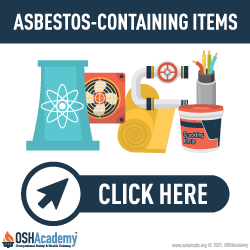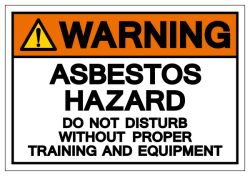Asbestos Exposure
When asbestos-containing material (ACM) and presumed asbestos-containing material (PACM) are disturbed, the tiny fibers may be released into the air and inhaled by unprotected workers.
Once inhaled, the fibers can become trapped in the lungs. If swallowed, the asbestos fibers can also become embedded in the digestive tract.
There are many potential asbestos sources which can unknowingly expose healthcare maintenance workers and engineers to asbestos.
Asbestos is most commonly found in older buildings, including hospitals, built before 1981. Buildings constructed after January 1981 are less likely to have asbestos-containing materials installed in them.
Asbestos may be found in many items such as:
- HVAC Duct Insulation
- boiler insulation
- pipe insulation
- cooling towers
- floor tile/ceiling tile
- electrical wiring insulation
- wall board or spackling compounds
Possible Solutions
To reduce your risk of exposure to asbestos, follow the Asbestos Standard for General Industry 29 CFR 1910.1001 .
Employers must do the following:
- Follow permissible exposure limits (PELs): 0.1 fibers per cubic centimeter of air (0.1 f/cc), averaged over an eight-hour work shift. The excursion or short-term limit is one fiber per cubic centimeter of air (1 f/cc) averaged over a sampling period of 30 minutes.
- Where exposure limits are exceeded, develop a written program to reduce employee exposure to or below limits by means of engineering, work practice controls, and respiratory protection.
- Only fully trained personnel should remove asbestos using methods and PPE covered in 1910.1001.
- Assume asphalt and vinyl flooring material, thermal system insulation, and sprayed-on or troweled-on surfacing materials in buildings older than 1980 are asbestos-containing.
- Ensure asbestos-containing material (ACM) is not sanded.
- Building and facility owners must determine and record the presence, location, and quantity of ACM and PACM. They must inform other employers and their own employees who will perform housekeeping, of the presence and location of ACM/PACM.
- Post signs at entrances to mechanical rooms/areas that contain ACM/PACM.
- Provide asbestos awareness training to employees who perform housekeeping in areas containing ACM or PACM.
- Keep training records for at least 1 year beyond the last date of employment, exposure monitoring records for at least 30 years, and worker medical surveillance records kept for the duration of employment plus 30 years.
Knowledge Check Choose the best answer for the question.
1-5. How long should we keep records on exposure monitoring for asbestos?
You forgot to answer the question!


